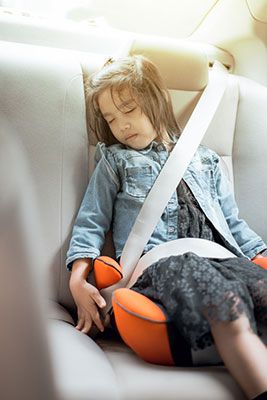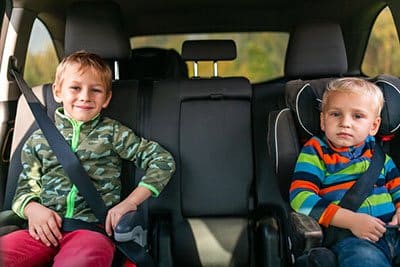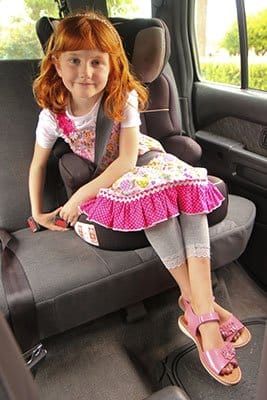If you're a parent looking to stay up-to-date on the latest car seat laws in the UK, then you've come to the right place.
Today, we unlock all of the important information surrounding booster seat regulations and discuss how they'll evolve in 2023.
Learn about age restrictions and height limits, and new rules for older children transitioning out of five-point harnesses and booster seats.
Let's dive into understanding why booster seat law UK are so essential for keeping your kids safe during their journeys!
More...
Take Away Key Points:
Table of Contents
- Booster child car seat or seat belt? What does the UK law say?
- Child car seat laws in the UK
- What's the proper child car seat in the UK?
- The difference between height and weight-based car seats
- Rear-facing infant car seat
- Forward-facing car seat (toddler seat)
- Booster seat
- ISOFIX car seat
- Seat belt system
- Children with disabilities and medical conditions
- Do you need a child car seat in a licensed taxi, mini cab, or Uber?
- Exceptions to the car seat laws
- What is the penalty for child not in car seat UK?
- Frequently Asked Questions
- Summary
Booster child car seat or seat belt? What does the UK law say?
If you want to know about booster seats and the official UK law, read the guide below. We've gathered crucial information to help you position your child correctly in the child restraint.
So, let's learn the official car seat law guidelines.
Child car seat laws in the UK

In the UK, children must use a correct child car seat until they are twelve years old, or 135cm/ 4 feet 5 inches tall, whichever comes first. Safety experts, however, recommend using a car seat for all children under 150cm/4 feet 11 inches.
Similarly, in Ireland and other European countries like France or Germany, the same rules control a legal requirement. For children weighing more than 36kg but under 150cm/4 feet 11 inches, it is recommended to go by height instead. safety standards require those aged 12 or 13 years old who are over 135cm/4 feet 5 inches can use the adult seat belt.
An important point to note is that only EU-approved car seats can be used in the UK. Thus, EU-approved car seats cannot be used in other countries such as the USA. Mistakenly using the wrong child car seat could risk your child's life and break the child car seat law.
What's the proper child car seat in the UK?
To ensure a safe car ride for your child, you must check that the car seat purchased meets the criteria of either United Nations standard, ECE Regulation 44/03 or ECE 44/04 (as indicated on a label on the seat), or is UN R129 certified (i-Size is a component of R129).
Additionally, child seats should be suitable for your child's weight and size or height if buying an i-Size seat, and it must be installed correctly as per the manufacturer's instructions.
The difference between height and weight-based car seats
Here are some of the differences between height-based seats and weight-based car seats:
1. Weight-based seats
Most child car seats are categorized according to the weight of the child they are designed to protect, in compliance with United Nations safety regulations.
These categories cover children from birth up until 12 years old, or 135cm (around 36kg). Transferring a baby or a young child to the next group before reaching the maximum weight or height limit for their seat could result in more severe injuries during a crash and is also illegal by the legal requirement.
2. Height-based car seats
As of April 2015, i-Size seats have been a part of R129, the European child car seat regulation. As opposed to weight, i-Size car seats are based on a child's height.
i-Size seats are only compatible with ISOFIX connectors; however, some baby car seats are still designed to be installed into the car using its adult seatbelt. By legal requirements, an infant must remain in a rear-facing seat while in an i-Size seat until they turn 15 months old.
The i-Size seats are designed to fit all vehicles that are certified with i-Size, as well as most cars that come equipped with Isofix. Before purchasing children's car seats for your vehicle, check with the manufacturer about which positions will suit the new seat you intend to buy.
Rear-facing infant car seat
The two main kinds of car seats for babies are infant carriers and fixed seat styles. Infant carriers come with their base, making them convenient to use, but they can be expensive.
Fixed rear-facing child seat styles may cost the same as an infant carrier but usually offer better value in the long run as they can be used up to a much higher age. It is important to note, however, that having a fixed rear-facing seat may be inconvenient if you are often in and out of the car.
The NHS recommends buying a baby seat before your baby's birth so that you can practice fitting it beforehand.
Rear seat types come under three groups:
- Group 0 for newborns up to 10 kg;
- Group 0+ for babies up to 13 kg (roughly 12-15 months);
- and Group 1 for infants 9 - 18 kg (about nine months to four years).
All baby seats in Groups 0 and 0+ should be used rear-facing to provide better protection for your baby's head, spine, and neck.
Forward-facing car seat (toddler seat)
When a baby outgrows the maximum child's height and weight limits in their rear-facing car seat, they'll need to graduate to a toddler seat - forward-facing car seat. The size guide and instruction manual should be consulted first since some vendors may refer to them as "baby seats" and others as "toddler seats".
A group 0+/1 combination seat is suitable for children up to 18kg (or about four years old) in the back seat of your vehicle. These car seats may appear larger than an infant carrier.
However, such car seats usually take up the same amount of room if you also use the base. In some cars, access can be restricted with a combination seat, which is why rotating seats make it much easier to load and unload your child.
Booster seat

Booster seats are designed to fit children between 15-36 kgs, lifting them to be in line with an adult's height so that they can use the car's seat belt. They are also referred to as "car child seats", which is the final stage before your child no longer needs to use a booster cushion when riding in a car.
Suppose your child weighs more than 22 kg or is 125 cm tall. In that case, you can opt for a 'booster cushion' (a backless booster seat) instead of one with a backrest (a high-backed booster seat). However, it is generally recommended that you keep the backrest in place for added protection, especially when side wings are incorporated.
When shopping for booster seats, you will refer to the following categories to find the right booster seat: the boosters belong to Groups 2 and 3.
Group 2 covers 16-25 kgs while Group 3 covers 22-36 kgs.
Combination seats (e.g. group 2/3) are available to purchase if your child falls within both weight categories - 15-36 kgs - but may lack the same level of protection compared to two separate options. Car seats that fall under groups 2 and 3 can either be front or rear-facing and utilize either the car's adult seatbelt, a harness, or a safety shield.
In addition, safety experts recommend you use a high-backed booster seat instead of the backless booster seats. The backless booster will not provide necessary protection in a car crash, even if a child travels a short distance. So, the backless booster cushions are not the best solution for an unexpected journey.
ISOFIX car seat
ISOFIX is an international standard for attaching child car seats to metal mounts that are already attached to the car frame. It's an alternative to using seat belts, and it makes securing the seat much easier.
To use a child car seat, simply click on the seat clips and then use either a foot prop or a Top Tether, depending on your vehicle. Most ISOFIX car seats have an indicator that will turn from red to green once it has been installed properly.
ISOFIX is a similar system but applies to larger seats (groups 2 and 3), with children being secured using the car's seat belts rather than a harness built into the child seat itself. Before buying an ISOFIX or ISOFIX seat, it is important to check that it is compatible with your specific car model.
Seat belt system
For a child aged 12-13 years old or younger and taller than 135cm, the driver is responsible for ensuring they wear an adult seat belt in both the front and back seat. Passengers over 14 years of age must also make sure to wear a seatbelt in both the front and rear seats.
You must ensure the kids properly use the seat belt system; otherwise, they might suffer from seat belt syndrome damaging their internal organs, spine, and soft tissue of the abdominal parts.
Children with disabilities and medical conditions
The same seatbelt rules apply for children with disabilities or medical conditions; however, they can use a disabled person's seatbelt or a child restraint designed specifically for their needs.
If it is impossible for a child to use either of these due to their condition, then a doctor can provide an exemption certificate for a child car seat based on their health conditions.
Do you need a child car seat in a licensed taxi, mini cab, or Uber?
A driver can be fined up to £500 if a child under 14 isn't in the correct car seat or isn't wearing a seat belt while driving. However, there are certain exceptions when traveling in private hire vehicles, such as taxis, minicabs, and Ubers:
- Coach drivers and companies do not have to provide child car seats
- Children under three can travel without a child's car seat or seat belt on the rear seats;
- Children aged three or older can travel in a rear seat without a child's car seat, provided they wear an adult's seatbelt;
- A survey found that 52% of parents thought they could be fined if they didn't use a car seat for their child in a taxi.
If you have a child under three years of age, some experts recommend sitting the child next to you on their seat (if possible) or bringing your car seat/using one provided by the taxi firm. It is not recommended to hold them on your lap as this may cause serious injury should a crash occur.
Exceptions to the car seat laws
There are other exceptions to the child car seat law:
- If there is no room for a third child seat in the back seat as two occupied child car seats prevent this, then a third child under the age of three can't travel unless they are in the front seat with the correct child seat;
- Children above the age of three can either use the front seat with the correct child seat or sit in the back using an adult belt;
- An unexpected but necessary journey over a short distance may not require a car seat if the child is over three years old, as they can utilize an adult's seatbelt instead;
- If a vehicle was originally produced without any seat belts, children under three could not travel unless they have their car seat, and children aged three or older can travel without either.
What is the penalty for child not in car seat UK?

Ignoring the legal requirements when using child car seats could have serious consequences. Police can issue an on-the-spot fine of up to £500 if the case goes to court.
The vehicle's driver is ultimately responsible for ensuring that all passengers are strapped in safely, so it's important for them to always check.
Fortunately, it seems that parents are becoming more aware of the fact that they can be fined if they don't use a car seat for their children or someone else's young children - a survey found that 88% and 86% of parents respectively know this.
Frequently Asked Questions
Can my 7-year-old sit in the front seat UK?
No, only kids aged 12 and older can sit in the front seat; all other kids must sit in the backseat.
Are booster seats still legal in the UK?
Yes, booster cushions are still legal in the UK, and you find the best car seat until your child is developed enough to use the seatbelt.
When can a child use a backless booster seat in the UK?
Your children can use backless boosters once they are 22 kg. Still, safety experts recommend you use high-backed booster cushions rather than backless boosters for more safety.
Are backless booster seats legal UK?
Yes, backless boosters are legal in the UK once your child weighs weighs 22kg and more.
When can you start using a booster seat in the UK?
Your kids can use boosters when they are between 15 and 36 kg of weight.
Summary
UK booster seat laws are pretty strict with safety requirements, setting a good example for all parents and caregivers to keep children safe on the road.
So, next time you're setting off on an unexpected journey, don't forget your car seat to protect your little one!
